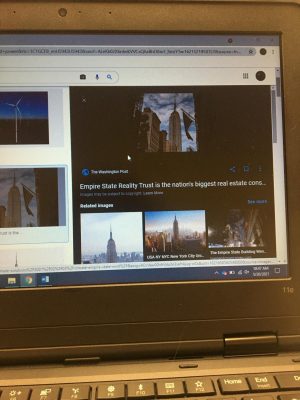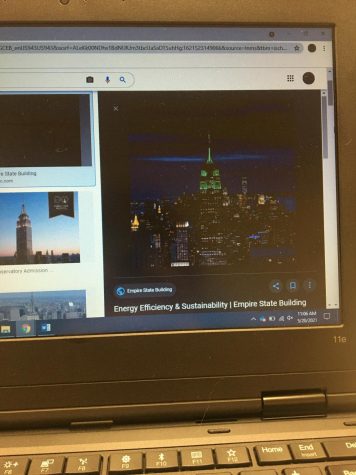The Empire State Building Strives for Sustainability
The Empire State Realty Trust, who owns the Empire State Building and 13 other office buildings, signed a multi-year contract switching to wind power.
Article author, Ava Fisher, visited New York City awhile ago and saw the skyline, which is viewable from the top of the Empire State Building, as well.

New York City’s iconic sky scraper, the Empire State Building, is becoming greener and greener as time goes on with it’s lights being powered by green energy, and now, it’s official switch to wind power.
With other buildings in New York City much less eco-friendly than this one, the Empire State building switching to green energy is showing that New York City may be slightly evolving into a more eco-friendly area. The Empire State Realty Trust (ESRT) signed a multi-year wind power contract with Green Mountain Energy and Direct Energy, which allowed for this green shift. The signing of the contracts enabled it to become the nation’s largest real estate user of fully renewable energy.
With the Empire State Building being as big as it is, switching to wind power will save a lot of energy throughout the city. This switch avoids the production of about four hundred and fifty million pounds of carbon dioxide, which is equal to “removing all New York City taxis from the road for an entire year,” The Washington Post noted.

Not only has the Empire State Building switched to greener energy, but so have thirteen other office buildings that are owned by the same company. The contracts signed by the Empire State Realty Trust on January 1st will provide an estimated three hundred million kilowatt hours of electricity for more than ten million-square-feet.
The company has been running on renewable energy for quite some time as well. Since 2011, the Empire State Building has run on renewable energy, cutting its emissions by about forty percent after a decade-long “deep carbon” retrofit enabled it.
The nation’s largest source of greenhouse gas emissions have always been from companies and buildings rather than single individuals. So, the ESRT cutting it’s carbon emissions by switching to green energy is monumental, especially because in New York, buildings generate more than two-thirds of the city’s carbon emissions.

“More and more building owners are understanding the critical role that our skyline plays in tackling climate change and how they can be an important part of the solution,” Donna De Costanzo, who’s a director for climate and clean energy at the Natural Resources Defense Council, stated. Though purchasing cleaner energy is slightly more expensive than any other energy source, big companies with tons of money would be able to afford this when it’ll work out for the better in the end. The ESRT declined to share the amount they spent on the renewable energy.
Though it may be more expensive for the energy itself, with buildings that need tenants, most of the money will be returned in response to rent prices being raised. “We want to differentiate ourselves so we get better tenants at higher rents so we can outperform our competition,” said Anthony Malkin, who’s the Trust’s chief executive. Also, the Empire State Reserve Trust’s tenant had been asking to switch to greener energy sources, so that was a motivator to the ESRT as well. When big companies begin to use green energy, other companies begin to use it as well, because of competition, which will inevitably lead to most companies not buying the old, un-sustainable energy anymore. “It’s so important to have examples like ESRT to show the nation that renewable power options are affordable and, dare I say, competitive,” said Cyndy Reynolds, who’s a commercial sales director for Green Mountain Energy.

Wind power is the most popular source of renewable energy in the United States, according to the Energy Information Administration. Data shows that the new wind power facilities are cheaper to build and operate than fossil fuel infrastructure, and factoring in tax credits and other incentives, generating wind can cost as little as nine dollars per one thousand kilowatt-hours, compared to at least twenty three dollars per kilowatt-hour at natural gas power plants. Though in New York the majority of electricity comes from natural gas-fired and nuclear power plants, the state passed legislation committed to meet seventy percent of its energy needs with renewable sources in 2019.
With this monument in New York City switching to green energy, it could motivate many others to follow in the same footsteps. However, New York seems to be taking the lead in moving towards a more sustainable future throughout the United States. New York passed the Climate Mobilization Act in 2019, which put forwards policies that are intended to make the city’s skyline one of the most sustainable in the world. Hopefully many other businesses follow suit in the near future that can help us lead to a greener and more sustainable society.




